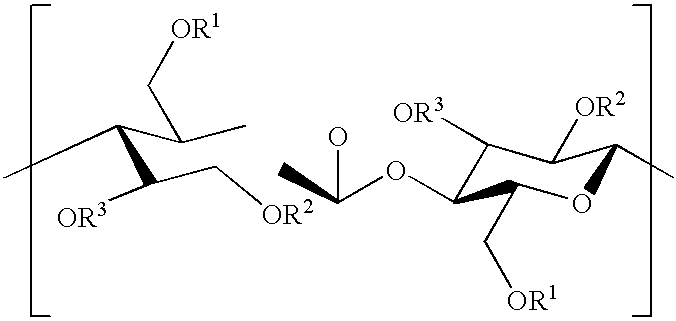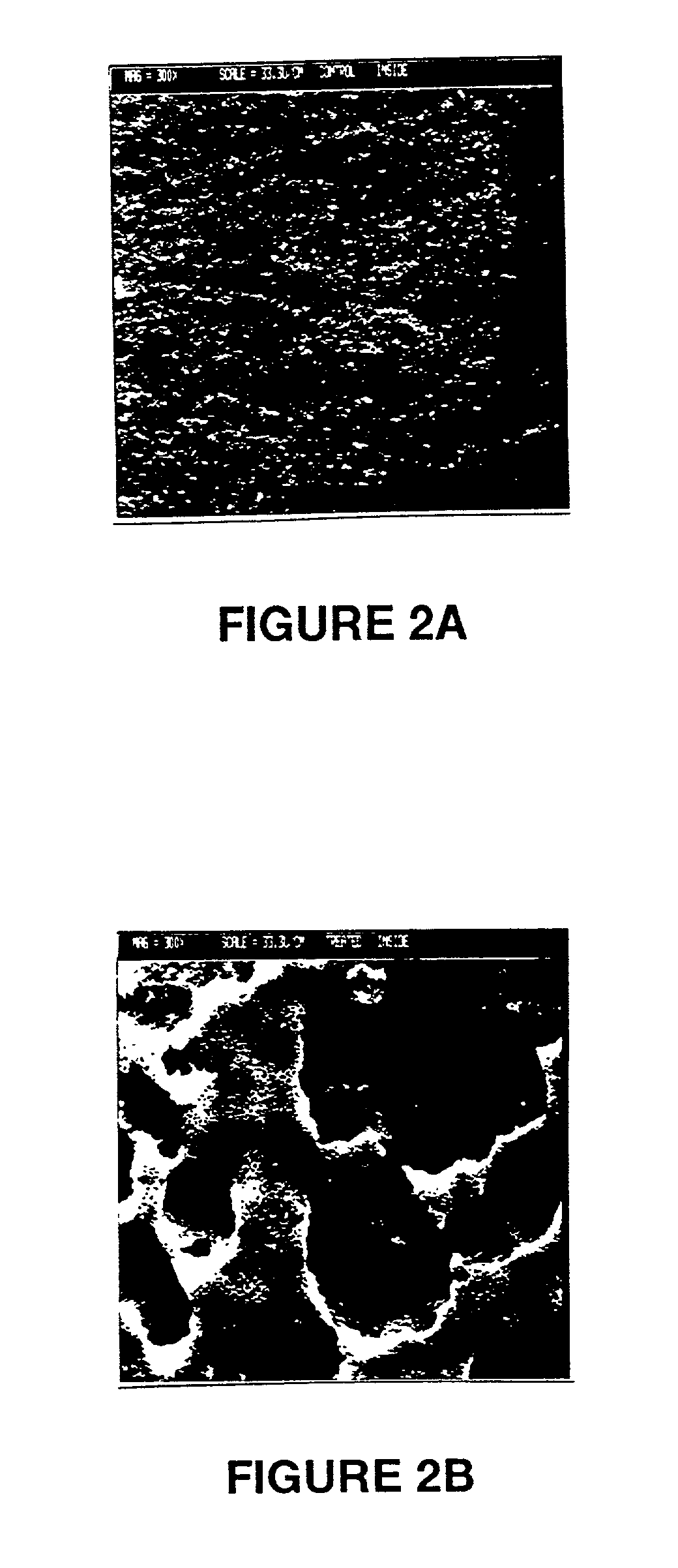Copolyesters and fibrous materials formed therefrom
a technology of fibrous materials and copolyesters, which is applied in the direction of bandages, weaving, yarn, etc., can solve the problems of putting enormous pressure on waste systems, accumulating disposable absorbent materials such as diapers in landfills, and adding a monomeric plasticizer
- Summary
- Abstract
- Description
- Claims
- Application Information
AI Technical Summary
Benefits of technology
Problems solved by technology
Method used
Image
Examples
example 1
[0196] Blends of cellulose acetate propionate (DS.sub.Ac=0.10, DS.sub.Pr=2.64, IV=1.3) and aliphatic-aromatic esters and films made from the blends were prepared using the standard procedures. Glass transition temperature were measured by DMTA and were calculated using the Fox-Flory on. The results are given in Tables I and II.
1TABLE I Tg. I.V., and Clarity of CAP / Aliphatic-Aromatic Copolyester Blends Tg Tg (exp) (cal) I.V. LV. Entry Polyester .degree. C. .degree. C. PE Blend Clarity 1 20% PTS(T) [85 / 15] 124 110 1.0 1.1 + 2 40% PTS(T) [85 / l5] 93 75 1.0 1.1 + 3 20% PTA(T) [85 / 15] 125 110 0.7 1.0 + 4 40% PTA(T) [85 / 15] 87 76 0.7 0.9 + 5 20% PEG(T) [85 / 15] 139 110 0.6 0.9 + 6 40% PEG(T) [85 / 15] 75 78 0.6 1.0 + 7 10% PEG(T) [70 / 30] 146 143 0.9 1.0 + 8 20% PEG(T) [70 / 30] 136 113 0.9 1.0 + 9 30% PEG(T) [70 / 30] 126* 97 0.9 1.0 + 10 40% PEG(T) [70 / 30] 82 83 0.6 1.0 + 11 55% PEG(T) [70 / 30] 62 59 0.6 0.9 + 12 70% PEG(T) [70 / 30] 25, 85, 98 34 0.9 0.9 + 13 40% PTG(T) [95 / 5] 93 66 1.2 nm + 14 20...
example 2
[0202] Blends of cellulose esters and succinate polyesters and films therefrom were prepared using the standard procedures. The results are given in Tables III and IV.
3TABLE III DS / AGU, I.V., and Clarity of Cellulose Ester / Polyester Blends: C4 Diacids I.V. I.V. I.V. Entry Polyester DS.sub.AC DS.sub.Pr DS.sub.Bu CE PE Blend Clarity 31 10% PES 2.50 -- -- 1.2 1.0 1.25 + 32 20% PES 2.50 ---- 1.2 1.0 1.18 + 33 20% PES 0.10 2.64 -- 1.3 1.1 1.18 + 34 40% PES 0.10 2.64 -- 1.3 1.0 1.11 + 35 20% 0.10 2.64 -- 1.3 1.0 1.16 + PHS 36 40% 0.10 2.64 -- 1.3 1.0 1.11 + PHS
[0203]
4TABLE IV Mechanical Properties and Tear Strength of Films Prepared From Cellulose Ester / Polyester Blends: C4 Diacids Tangent Tensile Tear Elongation Modulus Strength Strength Entry Polyster at Break (10.sup.5 psi) (10.sup.3 psi (g / mil) 31 10% PES Nm nm Nm nm 32 20% PES Nm nm Nm nm 33 20% PES 11 1.92 5.45 nm 34 40% PES 48 0.71 2.97 nm 35 20% 36 1.70 4.68 nm PHS 36 40% 87 0.26 2.32 12.2 PHS
[0204] The I.V. data from Table III il...
example 3
[0205] Blends of cellulose esters and glutarate polyesters and films therefrom were prepared using the standard procedures. The results are given in Tables V and VI.
5TABLE V DS / AGU, I.V., and Clarity of Cellulose Ester / Polyester Blends: C5 Diacids I.V. I.V. I.V. Entry Polyester DS.sub.AC DS.sub.Pr DS.sub.BU CE PE Blend Clarity 37 50% 2.50 -- -- 1.2 -- Nm + PEG 38 20% 0.10 2.64 -- 1.3 1.2 1.21 + PEG 39 40% 0.10 2.64 -- 1.3 1.2 1.19 + PEG 40 35% 0.34 2.15 -- 1.6 0.9 Nm + PEG 41 40% 0.34 2.15 -- 1.6 0.9 Nm + PEG 42 45% 0.34 2.15 -- 1.6 0.9 Nm + PEG 43 35% 0.12 2.14 -- 1.3 1.1 Nm + PEG 44 40% 0.12 2.14 -- 1.3 0.9 Nm + PEG 45 35% 0.11 2.05 -- 1.6 0.9 Nm + PEG 46 40% 0.11 2.05 -- 1.6 0.9 Nm + PEG 47 45% 0.11 2.05 -- 1.6 0.9 Nm + PEG 48 20% 0.10 2.64 -- 1.3 1.1 1.21 + PDEG 49 40% 0.10 2.64 -- 1.3 1.1 Nm + PDEG 50 40% 0.10 2.64 -- 1.3 0.7 Nm + PT(E)G [50, 50] 51 10% 0.10 2.64 -- 1.3 0.5 1.20 + PTG 52 20% 0.10 2.64 -- 1.3 0.5 1.21 + PTG 53 30% 0.10 2.64 -- 1.3 0.6 1.07 + PTG 54 35% 0.10 2.64...
PUM
| Property | Measurement | Unit |
|---|---|---|
| mole % | aaaaa | aaaaa |
| mole % | aaaaa | aaaaa |
| mole % | aaaaa | aaaaa |
Abstract
Description
Claims
Application Information
 Login to View More
Login to View More - R&D
- Intellectual Property
- Life Sciences
- Materials
- Tech Scout
- Unparalleled Data Quality
- Higher Quality Content
- 60% Fewer Hallucinations
Browse by: Latest US Patents, China's latest patents, Technical Efficacy Thesaurus, Application Domain, Technology Topic, Popular Technical Reports.
© 2025 PatSnap. All rights reserved.Legal|Privacy policy|Modern Slavery Act Transparency Statement|Sitemap|About US| Contact US: help@patsnap.com



